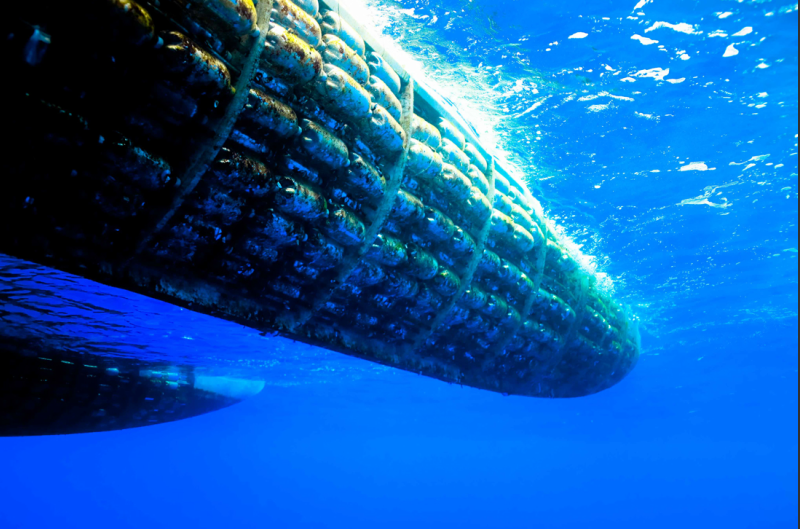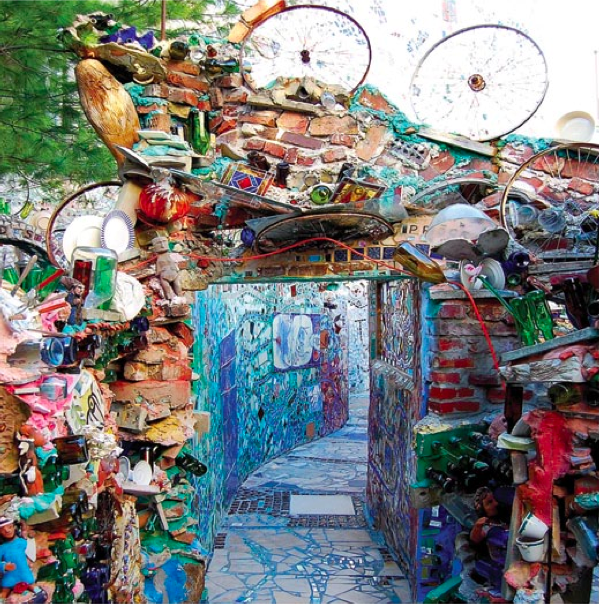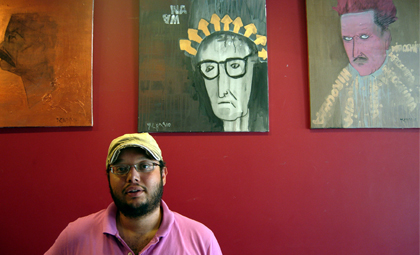
Courtesy of Plastiki
Designing a 60-foot catamaran using recycled plastic bottles is unimaginable for a sea voyage. However, a team of mostly British explorers, engineers, and environmentalists have pioneered a round-the-world expedition, using principles of sustainable design. The Plastiki concept took three years to conceive—on land. After reading a UNEP report, “Ecosystems and Biodiversity in Deep Waters and High Seas,” British banker David de Rothschild brainstormed ways to lessen the world’s sea- and ocean-bound plastic pollution. After consulting a team of experts, Plastiki was born and funding was secured.
Biomimicry provides answers
One of the members of the team, concept architect Michael Pawlyn, drew inspiration from Thor Heyerdahl’s epic 1947 expedition on the Kon-Tiki, in which a raft made of balsa husks used trade winds to set sail. At first, Pawlyn though kite sails could power Plastiki. Instead he settled on trimmable thin-layered plastic. To keep the vessel afloat, he incorporated biomimicry – a discipline that studies nature’s ideas and imitates its designs and processes to solve human- caused issues, i.e., studying a leaf to invent a better solar cell. “Pomegranates inspired the way to transform weak plastic bottles into extremely robust elements (using a couple of pellets of dry ice in recycled carbonated water bottles was an easy way of internally pressurizing the bottles),” says Pawlyn, proud of Plastiki’s 68 percent buoyancy.
Michael Grey coordinated the engineering and construction of the 12-ton vessel. In partnership with Dovell Naval Architects, Grey co-designed various prototypes, one of which used bamboo. Eventually, they settled on the safest model: a hull made of 12,500 reclaimed plastic bottles, held together by organic cashew nuts and sugar cane; a mast built from reclaimed aluminum irrigation pipe, and a skeleton and cabin constructed from Seretex (srPET) plastic panels, an alternative to fiberglass.
Grey attached 12-volt batteries to generate electricity, in addition to renewable sources: solar panels fixed on the cabin’s roof, two wind turbines mounted on the boat’s stern, and hydro- generators that trailed behind the vessel. Additional energy sources included a bicycle generator (an exercise machine, and a back-up if the battery ran low) and vacuum water evaporator for desalination.
Last March, after months of rigorous sea training and three days of testing, ten crew members climbed into their down-wind vessel and set sail from San Francisco, on average, moving at five knots per hour.
Even after they reached speeds of up to 70 knots, keeping boredom away posed a challenge for the crew after they adapted to the boat’s hectic schedule, and pit stops on the Pacific islands of Kiribati, Western Samoa, and New Caledonia were great distractions.
The crew slept on bunk beds and ate from a “vertical garden,” hung from the back mast. They had a stove, but no refrigerator and they showered in the rain and rinsed in minimal freshwater to avoid skin sores caused by exposure to salt and sun rays. Using a recovery system, urine was converted into water – an original Rothschild idea – while a separate waste storage with an evaporative technology system reduced the boat’s weight.
Staying connected at sea
Inmarsat, one of Plastiki’s partners, financed a wireless Internet connection using a satellite network. Electronic charts were used for navigation. Partner HP equipped crew members with IPAQ smartphones for personal blogging and checking weather reports, and notebook PCs for monitoring biometrics data, tracking power consumption, and editing videos. Thanks to the equipment, the world tracked their position online, requested interviews, and Tweeted.
While neither Michael was present, Olav and Josian Heyerdahl, Thor Heyerdahl’s grandchildren, safeguarded the original Kon-Tiki log book and their grandfather’s personal diary. Abroad they noted oceanic changes—plastic trails of garbage instead of sharks—and caught only one tuna. In Thor’s days, tuna had been plentiful.
Maneuvering Plastiki against crashing waves and strong winds posed challenges, and so did docking in the Sydney harbor. After ending their four-month journey, members of the crew have since returned to their daily responsibilities, hopped across continents, or started new projects. Sole female member and Skipper Jo Royle sailed the Pacific for the first time. “It was really interesting to have the opportunity to go about a project while continually balancing the most sustainable solution against the most practical,” says Royle, bringing to attention just how much the technology has changed in the past year. She is ocean-bound again, on another expedition.
Waste does not appear in nature

Courtesy of Plastiki
Plastiki recognized that waste is a “fundamental flaw.” It does not appear in nature. Plastiki showed the world that wasteful plastic materials can in fact be transformed into a valuable resource using sustainable design. It changed people’s linear thinking towards the life-cycle of plastics used in everyday consumption. In the United Kingdom alone, the plastics industry is worth 17.5 billion, and employs 220,000 people. The United Nations estimates that ninety-five percent of marine debris is plastic material.
Such figures only reinforces Plastiki’s message: dream, explore, educate…design sustainably. “Our ambition is to create a legacy project for the Plastiki that would see an educational exhibition showcase the Plastiki and all that she stands for tour ports throughout the world,” says Communications & Partnerships Executive Charlotte Bufton, from Rothschild’s company, MYOO. Let’s hope Her Majesty sets sail again, into the Port of Beirut.





